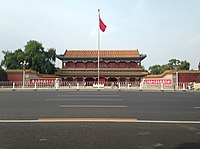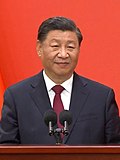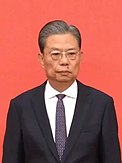
A | B | C | D | E | F | G | H | CH | I | J | K | L | M | N | O | P | Q | R | S | T | U | V | W | X | Y | Z | 0 | 1 | 2 | 3 | 4 | 5 | 6 | 7 | 8 | 9
People's Republic of China | |
|---|---|
| Anthem: 义勇军进行曲 Yìyǒngjūn Jìnxíngqǔ "March of the Volunteers" | |
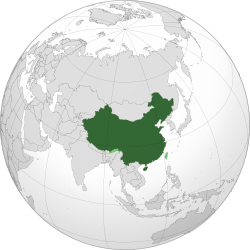 Location of the People's Republic of China | |
| Capital | Beijing 39°55′N 116°23′E / 39.917°N 116.383°E |
| Largest city by urban population | Shanghai |
| Official languages | Standard Chinese (de facto)[1] |
| Simplified Chinese | |
| Ethnic groups (2020)[2] |
|
| Religion (2023)[3] |
|
| Demonym(s) | Chinese |
| Government | Unitary Marxist–Leninist one-party socialist state |
| Xi Jinping | |
• Premier | Li Qiang |
| Zhao Leji | |
| Wang Huning | |
| Han Zheng | |
| Legislature | National People's Congress[d] |
| Formation | |
| c. 2070 BCE | |
| 221 BCE | |
| 1 January 1912 | |
| 24 October 1945[e] | |
| 1 October 1949 | |
| 20 September 1954 | |
| 4 December 1982 | |
| 20 December 1999 | |
| Area | |
• Total | 9,596,961 km2 (3,705,407 sq mi)[f][6] (3rd / 4th) |
• Water (%) | 2.8[g] |
| Population | |
• 2023 estimate | |
• Density | 145[9]/km2 (375.5/sq mi) (83rd) |
| GDP (PPP) | 2024 estimate |
• Total | |
• Per capita | |
| GDP (nominal) | 2024 estimate |
• Total | |
• Per capita | |
| Gini (2020) | medium |
| HDI (2022) | high (75th) |
| Currency | Renminbi (元/¥)[i] (CNY) |
| Time zone | UTC+8 (CST) |
| DST is not observed. | |
| Date format |
|
| Driving side | right (mainland) left (Hong Kong and Macau) |
| Calling code | +86 (mainland) +852 (Hong Kong) +853 (Macau) |
| ISO 3166 code | CN |
| Internet TLD | |
China,[j] officially the People's Republic of China (PRC),[k] is a country in East Asia. With a population exceeding 1.4 billion, it is the world's second-most populous country. China spans the equivalent of five time zones and borders fourteen countries by land.[l] With an area of nearly 9.6 million square kilometers (3,700,000 sq mi), it is the third-largest country by total land area.[m] The country is divided into 33[n] province-level divisions,[o] inclusive of 22 provinces,[o] five autonomous regions, four municipalities, and two semi-autonomous special administrative regions. Beijing is the national capital, while Shanghai is its most populous city and largest financial center.
One of the cradles of civilization, China has been inhabited since the Paleolithic era, with the earliest dynasties emerging in the Yellow River basin before the late second millennium BCE. The eighth to third centuries BCE saw a breakdown in the authority of the Zhou dynasty, accompanied by the emergence of administrative and military techniques, literature, philosophy, and historiography. In 221 BCE, China was unified under an emperor for the first time. Appointed non-hereditary officials began ruling counties instead of the aristocracy, ushering in more than two millennia of imperial dynasties including the Qin, Han, Tang, Yuan, Ming, and Qing. With the invention of gunpowder and paper, the establishment of the Silk Road, and the building of the Great Wall, Chinese culture—including languages, traditions, architecture, philosophy and technology—flourished and has heavily influenced East Asia and beyond.
After decades of struggle, the monarchy was overthrown in 1912 and the Republic of China (ROC) was established. Despite China's eventual victory in the Second Sino-Japanese War and the Pacific War in general, numerous atrocities such as the Nanjing Massacre left lasting effects on the country. Concurrently during this period, the Chinese Communist Party (CCP) and the Kuomintang (KMT) government were fighting sporadically since 1927, with a brief truce as a united front when Japan began invading the country. The second phase of the civil war resumed not long after Japan was defeated, and by 1949, the CCP had established control on most of the territories of the country. As the KMT retreated to Taiwan, the country was split with both sides claiming to be the sole legitimate government of China. After the land reforms, later attempts to realize communism failed—the Great Leap Forward led to a massive famine of millions of citizens, while the Cultural Revolution caused a chaotic period of persecution and zealous Maoist populism. In 1971, the PRC replaced the ROC as China's representation in the United Nations (UN). Following the Sino-Soviet split, the Shanghai Communiqué in 1972 marked the beginning of normalized relations with the United States. Economic reforms that began in 1978 led by reformists within the CCP moved the country away from a socialist planned economy toward an increasingly capitalist market economy, spurring significant economic growth, although liberal and democratic political reforms stalled after the June Fourth Incident in 1989.
China is a unitary one-party socialist republic led by the CCP. It is a founding member of the UN and one of the five permanent members of the UN Security Council. It is a founding member of several multilateral and regional organizations such as the AIIB, the Silk Road Fund, the New Development Bank, and the RCEP. It is a member of the BRICS, the G20, APEC, the SCO, and the East Asia Summit. Making up around one-fifth of the world economy, the Chinese economy is the world's largest economy by GDP at purchasing power parity, the second-largest economy by nominal GDP, and the second-wealthiest country, albeit ranking poorly in measures of democracy, human rights and religious freedoms. The country has been one of the fastest-growing major economies and is the world's largest manufacturer and exporter, as well as the second-largest importer. China is a nuclear-weapon state with the world's largest standing army by military personnel and the second-largest defense budget. It is a great power and a regional power.
Etymology
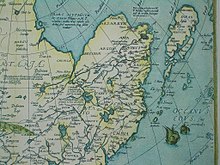
The word "China" has been used in English since the 16th century; however, it was not used by the Chinese themselves during this period. Its origin has been traced through Portuguese, Malay, and Persian back to the Sanskrit word Cīna, used in ancient India.[15] "China" appears in Richard Eden's 1555 translation[p] of the 1516 journal of the Portuguese explorer Duarte Barbosa.[q][15] Barbosa's usage was derived from Persian Chīn (چین), which in turn derived from Sanskrit Cīna (चीन).[20] Cīna was first used in early Hindu scripture, including the Mahabharata (5th century BCE) and the Laws of Manu (2nd century BCE).[21] In 1655, Martino Martini suggested that the word China is derived ultimately from the name of the Qin dynasty (221–206 BCE).[22][21] Although use in Indian sources precedes this dynasty, this derivation is still given in various sources.[23] The origin of the Sanskrit word is a matter of debate.[15] Alternative suggestions include the names for Yelang and the Jing or Chu state.[21][24]
The official name of the modern state is the "People's Republic of China" (simplified Chinese: 中华人民共和国; traditional Chinese: 中華人民共和國; pinyin: Zhōnghuá rénmín gònghéguó). The shorter form is "China" (中国; 中國; Zhōngguó), from zhōng ('central') and guó ('state'), a term which developed under the Western Zhou dynasty in reference to its royal demesne.[r][s] It was used in official documents as an synonym for the state under the Qing.[27] The name Zhongguo is also translated as 'Middle Kingdom' in English.[28] China is sometimes referred to as "mainland China" or "the Mainland" when distinguishing it from the Republic of China.[29][30][31][32]
History
Prehistory
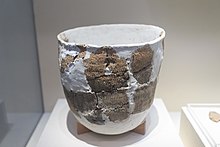
Archaeological evidence suggests that early hominids inhabited China 2.25 million years ago.[33] The hominid fossils of Peking Man, a Homo erectus who used fire,[34] have been dated to between 680,000 and 780,000 years ago.[35] The fossilized teeth of Homo sapiens (dated to 125,000–80,000 years ago) have been discovered in Fuyan Cave.[36] Chinese proto-writing existed in Jiahu around 6600 BCE,[37] at Damaidi around 6000 BCE,[38] Dadiwan from 5800 to 5400 BCE, and Banpo dating from the 5th millennium BCE. Some scholars have suggested that the Jiahu symbols (7th millennium BCE) constituted the earliest Chinese writing system.[37]
Early dynastic rule

According to traditional Chinese historiography, the Xia dynasty was established during the late third millennium BC, marking the beginning of the dynastic cycle that was understood to underpin China's entire political history. In the modern era, the Xia's historicity came under increasing scrutiny, in part due to the earliest known attestation of the Xia being written millennia after the date given for their collapse. In 1958, archaeologists discovered sites belonging to the Erlitou culture that existed during the early Bronze Age; they have since been characterized as the remains of the historical Xia, but this conception is often rejected.[39][40][41] The Shang dynasty that traditionally succeeded the Xia is the earliest for which there are both contemporary written records and undisputed archaeological evidence.[42] The Shang ruled much of the Yellow River valley until the 11th century BCE, with the earliest hard evidence dating to c. 1300 BCE.[43] The oracle bone script, attested from c. 1250 BCE but generally assumed to be considerably older,[44][45] represents the oldest known form of written Chinese,[46] and is the direct ancestor of modern Chinese characters.[47]
The Shang were overthrown by the Zhou, who ruled between the 11th and 5th centuries BCE, though the centralized authority of Tianzi was slowly eroded by Fengjiang lords. Some principalities eventually emerged from the weakened Zhou and continually waged war with each other during the 300-year Spring and Autumn period. By the time of the Warring States period of the 5th–3rd centuries BCE, there were seven major powerful states left.[48]
Imperial China
Qin and Han
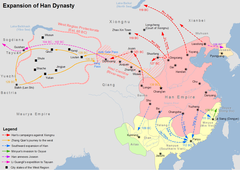
The Warring States period ended in 221 BCE after the state of Qin conquered the other six states, reunited China and established the dominant order of autocracy. King Zheng of Qin proclaimed himself the Emperor of the Qin dynasty, becoming the first emperor of a unified China. He enacted Qin's legalist reforms, notably the standardization of Chinese characters, measurements, road widths, and currency. His dynasty also conquered the Yue tribes in Guangxi, Guangdong, and Northern Vietnam.[49] The Qin dynasty lasted only fifteen years, falling soon after the First Emperor's death.[50][51]
Following widespread revolts during which the imperial library was burned,[t] the Han dynasty emerged to rule China between 206 BCE and CE 220, creating a cultural identity among its populace still remembered in the ethnonym of the modern Han Chinese.[50][51] The Han expanded the empire's territory considerably, with military campaigns reaching Central Asia, Mongolia, Korea, and Yunnan, and the recovery of Guangdong and northern Vietnam from Nanyue. Han involvement in Central Asia and Sogdia helped establish the land route of the Silk Road, replacing the earlier path over the Himalayas to India. Han China gradually became the largest economy of the ancient world.[53] Despite the Han's initial decentralization and the official abandonment of the Qin philosophy of Legalism in favor of Confucianism, Qin's legalist institutions and policies continued to be employed by the Han government and its successors.[54]
Three Kingdoms, Jin, Northern and Southern dynasties
After the end of the Han dynasty, a period of strife known as Three Kingdoms followed, at the end of which Wei was swiftly overthrown by the Jin dynasty. The Jin fell to civil war upon the ascension of a developmentally disabled emperor; the Five Barbarians then rebelled and ruled northern China as the Sixteen States. The Xianbei unified them as the Northern Wei, whose Emperor Xiaowen reversed his predecessors' apartheid policies and enforced a drastic sinification on his subjects. In the south, the general Liu Yu secured the abdication of the Jin in favor of the Liu Song. The various successors of these states became known as the Northern and Southern dynasties, with the two areas finally reunited by the Sui in 581.
Sui, Tang and Song
The Sui restored the Han to power through China, reformed its agriculture, economy and imperial examination system, constructed the Grand Canal, and patronized Buddhism. However, they fell quickly when their conscription for public works and a failed war in northern Korea provoked widespread unrest.[55][56]
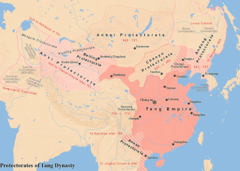
Under the succeeding Tang and Song dynasties, Chinese economy, technology, and culture entered a golden age.[57] The Tang dynasty retained control of the Western Regions and the Silk Road,[58] which brought traders to as far as Mesopotamia and the Horn of Africa,[59] and made the capital Chang'an a cosmopolitan urban center. However, it was devastated and weakened by the An Lushan rebellion in the 8th century.[60] In 907, the Tang disintegrated completely when the local military governors became ungovernable. The Song dynasty ended the separatist situation in 960, leading to a balance of power between the Song and the Liao dynasty. The Song was the first government in world history to issue paper money and the first Chinese polity to establish a permanent navy which was supported by the developed shipbuilding industry along with the sea trade.[61]
Between the 10th and 11th century CE, the population of China doubled to around 100 million people, mostly because of the expansion of rice cultivation in central and southern China, and the production of abundant food surpluses. The Song dynasty also saw a revival of Confucianism, in response to the growth of Buddhism during the Tang,[62] and a flourishing of philosophy and the arts, as landscape art and porcelain were brought to new levels of complexity.[63][64] However, the military weakness of the Song army was observed by the Jin dynasty. In 1127, Emperor Huizong of Song and the capital Bianjing were captured during the Jin–Song Wars. The remnants of the Song retreated to southern China.[65]
Yuan
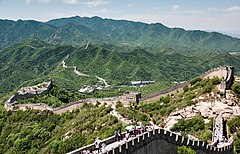
The Mongol conquest of China began in 1205 with the gradual conquest of Western Xia by Genghis Khan,[66] who also invaded Jin territories.[67] In 1271, the Mongol leader Kublai Khan established the Yuan dynasty, which conquered the last remnant of the Song dynasty in 1279. Before the Mongol invasion, the population of Song China was 120 million citizens; this was reduced to 60 million by the time of the census in 1300.[68] A peasant named Zhu Yuanzhang overthrew the Yuan in 1368 and founded the Ming dynasty as the Hongwu Emperor. Under the Ming dynasty, China enjoyed another golden age, developing one of the strongest navies in the world and a rich and prosperous economy amid a flourishing of art and culture. It was during this period that admiral Zheng He led the Ming treasure voyages throughout the Indian Ocean, reaching as far as East Africa.[69]
Ming
In the early Ming dynasty, China's capital was moved from Nanjing to Beijing. With the budding of capitalism, philosophers such as Wang Yangming critiqued and expanded Neo-Confucianism with concepts of individualism and equality of four occupations.[70] The scholar-official stratum became a supporting force of industry and commerce in the tax boycott movements, which, together with the famines and defense against Japanese invasions of Korea (1592–1598) and Later Jin incursions led to an exhausted treasury.[71] In 1644, Beijing was captured by a coalition of peasant rebel forces led by Li Zicheng. The Chongzhen Emperor committed suicide when the city fell. The Manchu Qing dynasty, then allied with Ming dynasty general Wu Sangui, overthrew Li's short-lived Shun dynasty and subsequently seized control of Beijing, which became the new capital of the Qing dynasty.[72]
Qing

The Qing dynasty, which lasted from 1644 until 1912, was the last imperial dynasty of China. The Ming-Qing transition (1618–1683) cost 25 million lives, but the Qing appeared to have restored China's imperial power and inaugurated another flowering of the arts.[73] After the Southern Ming ended, the further conquest of the Dzungar Khanate added Mongolia, Tibet and Xinjiang to the empire.[74] Meanwhile, China's population growth resumed and shortly began to accelerate. It is commonly agreed that pre-modern China's population experienced two growth spurts, one during the Northern Song period (960–1127), and other during the Qing period (around 1700–1830).[75] By the High Qing era China was possibly the most commercialized country in the world, and imperial China experienced a second commercial revolution by the end of the 18th century.[76] On the other hand, the centralized autocracy was strengthened in part to suppress anti-Qing sentiment with the policy of valuing agriculture and restraining commerce, like the Haijin during the early Qing period and ideological control as represented by the literary inquisition, causing some social and technological stagnation.[77][78]
Fall of the Qing dynasty
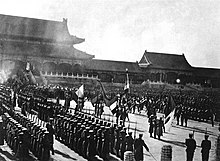
In the mid-19th century, the Opium Wars with Britain and France forced China to pay compensation, open treaty ports, allow extraterritoriality for foreign nationals, and cede Hong Kong to the British[79] under the 1842 Treaty of Nanking, the first of what have been termed as the "unequal treaties". The First Sino-Japanese War (1894–1895) resulted in Qing China's loss of influence in the Korean Peninsula, as well as the cession of Taiwan to Japan.[80] The Qing dynasty also began experiencing internal unrest in which tens of millions of people died, especially in the White Lotus Rebellion, the failed Taiping Rebellion that ravaged southern China in the 1850s and 1860s and the Dungan Revolt (1862–1877) in the northwest. The initial success of the Self-Strengthening Movement of the 1860s was frustrated by a series of military defeats in the 1880s and 1890s.[81]
In the 19th century, the great Chinese diaspora began. Losses due to emigration were added to by conflicts and catastrophes such as the Northern Chinese Famine of 1876–1879, in which between 9 and 13 million people died.[82] The Guangxu Emperor drafted a reform plan in 1898 to establish a modern constitutional monarchy, but these plans were thwarted by the Empress Dowager Cixi. The ill-fated anti-foreign Boxer Rebellion of 1899–1901 further weakened the dynasty. Although Cixi sponsored a program of reforms known as the late Qing reforms, the Xinhai Revolution of 1911–1912 ended the Qing dynasty and established the Republic of China.[83] Puyi, the last Emperor, abdicated in 1912.[84]
Establishment of the Republic and World War II
On 1 January 1912, the Republic of China was established, and Sun Yat-sen of the Kuomintang (KMT) was proclaimed provisional president.[85] In March 1912, the presidency was given to Yuan Shikai, a former Qing general who in 1915 proclaimed himself Emperor of China. In the face of popular condemnation and opposition from his own Beiyang Army, he was forced to abdicate and re-establish the republic in 1916.[86] After Yuan Shikai's death in 1916, China was politically fragmented. Its Beijing-based government was internationally recognized but virtually powerless; regional warlords controlled most of its territory.[87][88] During this period, China participated in World War I and saw a far-reaching popular uprising (the May Fourth Movement).[89]

In the late 1920s, the Kuomintang under Chiang Kai-shek was able to reunify the country under its own control with a series of deft military and political maneuverings known collectively as the Northern Expedition.[90][91] The Kuomintang moved the nation's capital to Nanjing and implemented "political tutelage", an intermediate stage of political development outlined in Sun Yat-sen's Three Principles of the People program for transforming China into a modern democratic state.[92][93] The Kuomintang briefly allied with the Chinese Communist Party (CCP) during the Northern Expedition, though the alliance broke down in 1927 after Chiang violently suppressed the CCP and other leftists Shanghai, marking the beginning of the Chinese Civil War.[94] The CCP declared areas of the country as the Chinese Soviet Republic (Jiangxi Soviet) in November 1931 in Ruijin, Jiangxi. The Jiangxi Soviet was wiped out by the KMT armies in 1934, leading the CCP to initiate the Long March and relocate to Yan'an in Shaanxi. It would be the base of the communists before major combat in the Chinese Civil War ended in 1949.
In 1931, Japan invaded and occupied Manchuria. Japan invaded other parts of China in 1937, precipitating the Second Sino-Japanese War (1937–1945), a theater of World War II. The war forced an uneasy alliance between the Kuomintang and the CCP. Japanese forces committed numerous war atrocities against the civilian population; as many as 20 million Chinese civilians died.[95] An estimated 40,000 to 300,000 Chinese were massacred in Nanjing alone during the Japanese occupation.[96] China, along with the UK, the United States, and the Soviet Union, were recognized as the Allied "Big Four" in the Declaration by United Nations.[97][98] Along with the other three great powers, China was one of the four major Allies of World War II, and was later considered one of the primary victors in the war.[99][100] After the surrender of Japan in 1945, Taiwan, including the Penghu, was handed over to Chinese control; however, the validity of this handover is controversial.[101]
People's Republic

China emerged victorious but war-ravaged and financially drained. The continued distrust between the Kuomintang and the Communists led to the resumption of civil war. Constitutional rule was established in 1947, but because of the ongoing unrest, many provisions of the ROC constitution were never implemented in mainland China.[101] Afterwards, the CCP took control of most of mainland China, and the ROC government retreated offshore to Taiwan.
On 1 October 1949, CCP Chairman Mao Zedong formally proclaimed the People's Republic of China in Tiananmen Square, Beijing.[103] In 1950, the PRC captured Hainan from the ROC[104] and annexed Tibet.[105] However, remaining Kuomintang forces continued to wage an insurgency in western China throughout the 1950s.[106] The CCP consolidated its popularity among the peasants through the Land Reform Movement, which included the state-tolerated executions of between 1 and 2 million landlords by peasants and former tenants.[107] Though the PRC initially allied closely with the Soviet Union, the relations between the two communist nations gradually deteriorated, leading China to develop an independent industrial system and its own nuclear weapons.[108]
The Chinese population increased from 550 million in 1950 to 900 million in 1974.[109] However, the Great Leap Forward, an idealistic massive industrialization project, resulted in an estimated 15 to 55 million deaths between 1959 and 1961, mostly from starvation.[110][111] In 1964, China's first atomic bomb exploded successfully.[112] In 1966, Mao and his allies launched the Cultural Revolution, sparking a decade of political recrimination and social upheaval that lasted until Mao's death in 1976. In October 1971, the PRC replaced the ROC in the United Nations, and took its seat as a permanent member of the Security Council.[113]
Reforms and contemporary history

After Mao's death, the Gang of Four was arrested by Hua Guofeng and held responsible for the Cultural Revolution. The Cultural Revolution was rebuked, with millions rehabilitated. Deng Xiaoping took power in 1978, and instituted large-scale political and economic reforms, together with the "Eight Elders", most senior and influential members of the party. The government loosened its control and the communes were gradually disbanded.[114] Agricultural collectivization was dismantled and farmlands privatized. While foreign trade became a major focus, special economic zones (SEZs) were created. Inefficient state-owned enterprises (SOEs) were restructured and some closed. This marked China's transition away from planned economy.[115] China adopted its current constitution on 4 December 1982.
In 1989, the country saw the protests in Tiananmen Square unfold, and later saw other protests over the entire nation.[116] Zhao Ziyang was put under house arrest for his sympathies to the protests and was replaced by Jiang Zemin. Jiang continued economic reforms, closing many SOEs and trimming down "iron rice bowl" (life-tenure positions).[117][118][119] China's economy grew sevenfold during this time.[117] British Hong Kong and Portuguese Macau returned to China in 1997 and 1999, respectively, as special administrative regions under the principle of one country, two systems. The country joined the World Trade Organization in 2001.[117]
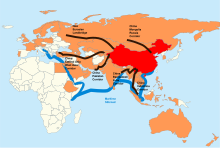
On the 16th CCP National Congress in 2002, Hu Jintao succeeded Jiang as the general secretary.[117] Under Hu, China maintained its high rate of economic growth, overtaking the United Kingdom, France, Germany and Japan to become the world's second-largest economy.[120] However, the growth also severely impacted the country's resources and environment,[121][122] and caused major social displacement.[123][124] Xi Jinping succeeded Hu as paramount leader on the 18th CCP National Congress in 2012. Shortly after his ascension to power, Xi launched a vast anti-corruption crackdown,[125] that prosecuted more than 2 million officials by 2022.[126] During his tenure, Xi consolidated power unseen since the initiation of economic and political reforms.[127]
Geography
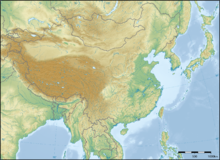
China's landscape is vast and diverse, ranging from the Gobi and Taklamakan Deserts in the arid north to the subtropical forests in the wetter south. The Himalaya, Karakoram, Pamir and Tian Shan mountain ranges separate China from much of South and Central Asia. The Yangtze and Yellow Rivers, the third- and sixth-longest in the world, respectively, run from the Tibetan Plateau to the densely populated eastern seaboard. China's coastline along the Pacific Ocean is 14,500 km (9,000 mi) long and is bounded by the Bohai, Yellow, East China and South China seas. China connects through the Kazakh border to the Eurasian Steppe.
The territory of China lies between latitudes 18° and 54° N, and longitudes 73° and 135° E. The geographical center of China is marked by the Center of the Country Monument at 35°50′40.9″N 103°27′7.5″E / 35.844694°N 103.452083°E. China's landscapes vary significantly across its vast territory. In the east, along the shores of the Yellow Sea and the East China Sea, there are extensive and densely populated alluvial plains, while on the edges of the Inner Mongolian plateau in the north, broad grasslands predominate. Southern China is dominated by hills and low mountain ranges, while the central-east hosts the deltas of China's two major rivers, the Yellow River and the Yangtze River. Other major rivers include the Xi, Mekong, Brahmaputra and Amur. To the west sit major mountain ranges, most notably the Himalayas. High plateaus feature among the more arid landscapes of the north, such as the Taklamakan and the Gobi Desert. The world's highest point, Mount Everest (8,848 m), lies on the Sino-Nepalese border.[128] The country's lowest point, and the world's third-lowest, is the dried lake bed of Ayding Lake (−154 m) in the Turpan Depression.[129]
Climate
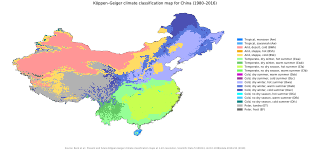
China's climate is mainly dominated by dry seasons and wet monsoons, which lead to pronounced temperature differences between winter and summer. In the winter, northern winds coming from high-latitude areas are cold and dry; in summer, southern winds from coastal areas at lower latitudes are warm and moist.[131]
A major environmental issue in China is the continued expansion of its deserts, particularly the Gobi Desert.[132][133] Although barrier tree lines planted since the 1970s have reduced the frequency of sandstorms, prolonged drought and poor agricultural practices have resulted in dust storms plaguing northern China each spring, which then spread to other parts of East Asia, including Japan and Korea. Water quality, erosion, and pollution control have become important issues in China's relations with other countries. Melting glaciers in the Himalayas could potentially lead to water shortages for hundreds of millions of people.[134] According to academics, in order to limit climate change in China to 1.5 °C (2.7 °F) electricity generation from coal in China without carbon capture must be phased out by 2045.[135] With current policies, the GHG emissions of China will probably peak in 2025, and by 2030 they will return to 2022 levels. However, such pathway still leads to three-degree temperature rise.[136]
Official government statistics about Chinese agricultural productivity are considered unreliable, due to exaggeration of production at subsidiary government levels.[137][138] Much of China has a climate very suitable for agriculture and the country has been the world's largest producer of rice, wheat, tomatoes, eggplant, grapes, watermelon, spinach, and many other crops.[139] In 2021, 12 percent of global permanent meadows and pastures belonged to China, as well as 8% of global cropland.[140]
Biodiversity
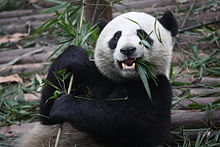
China is one of 17 megadiverse countries,[141] lying in two of the world's major biogeographic realms: the Palearctic and the Indomalayan. By one measure, China has over 34,687 species of animals and vascular plants, making it the third-most biodiverse country in the world, after Brazil and Colombia.[142] The country is a party to the Convention on Biological Diversity;[143] its National Biodiversity Strategy and Action Plan was received by the convention in 2010.[144]
China is home to at least 551 species of mammals (the third-highest in the world),[145] 1,221 species of birds (eighth),[146] 424 species of reptiles (seventh)[147] and 333 species of amphibians (seventh).[148] Wildlife in China shares habitat with, and bears acute pressure from, one of the world's largest population of humans. At least 840 animal species are threatened, vulnerable or in danger of local extinction, due mainly to human activity such as habitat destruction, pollution and poaching for food, fur and traditional Chinese medicine.[149] Endangered wildlife is protected by law, and as of 2005[update], the country has over 2,349 nature reserves, covering a total area of 149.95 million hectares, 15 percent of China's total land area.[150] Most wild animals have been eliminated from the core agricultural regions of east and central China, but they have fared better in the mountainous south and west.[151][152] The Baiji was confirmed extinct on 12 December 2006.[153]
China has over 32,000 species of vascular plants,[154] and is home to a variety of forest types. Cold coniferous forests predominate in the north of the country, supporting animal species such as moose and Asian black bear, along with over 120 bird species.[155] The understory of moist conifer forests may contain thickets of bamboo. In higher montane stands of juniper and yew, the bamboo is replaced by rhododendrons. Subtropical forests, which are predominate in central and southern China, support a high density of plant species including numerous rare endemics. Tropical and seasonal rainforests, though confined to Yunnan and Hainan, contain a quarter of all the animal and plant species found in China.[155] China has over 10,000 recorded species of fungi.[156]
Environment
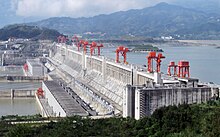
In the early 2000s, China has suffered from environmental deterioration and pollution due to its rapid pace of industrialization.[157][158] Regulations such as the 1979 Environmental Protection Law are fairly stringent, though they are poorly enforced, frequently disregarded in favor of rapid economic development.[159] China has the second highest death toll because of air pollution, after India, with approximately 1 million deaths.[160][161] Although China ranks as the highest CO2 emitting country,[162] it only emits 8 tons of CO2 per capita, significantly lower than developed countries such as the United States (16.1), Australia (16.8) and South Korea (13.6).[163] Greenhouse gas emissions by China are the world's largest.[163] The country has significant water pollution problems; only 87.9% of China's national surface water was graded suitable for human consumption by the Ministry of Ecology and Environment in 2022.[164]
China has prioritized clamping down on pollution, bringing a significant decrease in air pollution in the 2010s.[165] In 2020, the Chinese government announced its aims for the country to reach its peak emissions levels before 2030, and achieve carbon neutrality by 2060 in line with the Paris Agreement,[166] which, according to Climate Action Tracker, would lower the expected rise in global temperature by 0.2–0.3 degrees – "the biggest single reduction ever estimated by the Climate Action Tracker".[166]
China is the world's leading investor in renewable energy and its commercialization, with $546 billion invested in 2022;[167] it is a major manufacturer of renewable energy technologies and invests heavily in local-scale renewable energy projects.[168][167] Long heavily relying on non-renewable energy sources such as coal, China's adaptation of renewable energy has increased significantly in recent years, with their share increasing from 26.3 percent in 2016 to 31.9 percent in 2022.[169] In 2022, 61.2% of China's electricity came from coal (largest producer in the world), 14.9% from hydroelectric power (largest), 9.3% from wind (largest), 4.7% from solar energy (largest), 4.7% from nuclear energy (second-largest), 3.1% from natural gas (fifth-largest), and 1.9% from bioenergy (largest); in total, 30.8% of China's energy came from renewable energy sources.[170] Despite its emphasis on renewables, China remains deeply connected to global oil markets and next to India, has been the largest importer of Russian crude oil in 2022.[171][172]
Political geography
China is the third-largest country in the world by land area after Russia, and the third or fourth largest country in the world by total area.[u] China's total area is generally stated as being approximately 9,600,000 km2 (3,700,000 sq mi).[173] Specific area figures range from 9,572,900 km2 (3,696,100 sq mi) according to the Encyclopædia Britannica,[13] to 9,596,961 km2 (3,705,407 sq mi) according to the UN Demographic Yearbook,[4] and The World Factbook.[7]
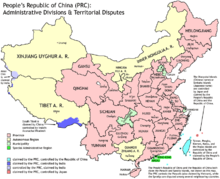
China has the longest combined land border in the world, measuring 22,117 km (13,743 mi) and its coastline covers approximately 14,500 km (9,000 mi) from the mouth of the Yalu River (Amnok River) to the Gulf of Tonkin.[7] China borders 14 nations and covers the bulk of East Asia, bordering Vietnam, Laos, and Myanmar in Southeast Asia; India, Bhutan, Nepal, Pakistan[v] and Afghanistan in South Asia; Tajikistan, Kyrgyzstan and Kazakhstan in Central Asia; and Russia, Mongolia, and North Korea in Inner Asia and Northeast Asia. It is narrowly separated from Bangladesh and Thailand to the southwest and south, and has several maritime neighbors such as Japan, Philippines, Malaysia, and Indonesia.[174]
China has resolved its land borders with 12 out of 14 neighboring countries, having pursued substantial compromises in most of them.[175][176][177] China currently has a disputed land border with India[178] and Bhutan.[179] China is additionally involved in maritime disputes with multiple countries over territory in the East and South China Seas, such as the Senkaku Islands and the entirety of South China Sea Islands.[180][181]
Politics
The People's Republic of China is a one-party state governed by the Chinese Communist Party (CCP), which considers itself to be Marxist–Leninist. This makes China one of the few countries governed by a communist party. The Chinese constitution states that the PRC "is a socialist state governed by a people's democratic dictatorship that is led by the working class and based on an alliance of workers and peasants," that the state institutions "shall practice the principle of democratic centralism,"[182] and that "the defining feature of socialism with Chinese characteristics is the leadership of the Chinese Communist Party."[183]
The PRC officially terms itself as a democracy, using terms such as "socialist consultative democracy",[184] and "whole-process people's democracy".[185] However, the country is commonly described as an authoritarian one-party state and a dictatorship,[186][187] with among the heaviest restrictions worldwide in many areas, most notably against freedom of the press, freedom of assembly, reproductive rights, free formation of social organizations, freedom of religion and free access to the Internet.[188] China has consistently been ranked amongst the lowest as an "authoritarian regime" by the Economist Intelligence Unit's Democracy Index, ranking at 148th out of 167 countries in 2023.[189]
Chinese Communist Party

According to the CCP constitution, its highest body is the National Congress held every five years.[190] The National Congress elects the Central Committee, who then elects the party's Politburo, Politburo Standing Committee and the general secretary (party leader), the top leadership of the country.[190] The general secretary holds ultimate power and authority over state and government and serves as the informal paramount leader.[191] The current general secretary is Xi Jinping, who took office on 15 November 2012.[192] At the local level, the secretary of the CCP committee of a subdivision outranks the local government level; CCP committee secretary of a provincial division outranks the governor while the CCP committee secretary of a city outranks the mayor.[193] The CCP is officially guided by Marxism adapted to Chinese circumstances.[194]
Government
The government in China is under the sole control of the CCP.[195] The CCP controls appointments in government bodies, with most senior government officials being CCP members.[195]
The National People's Congress (NPC), with nearly 3,000-members, is constitutionally the "highest organ of state power",[182] though it has been also described as a "rubber stamp" body.[196] The NPC meets annually, while the NPC Standing Committee, around 150 members elected from NPC delegates, meets every couple of months.[196] Elections are indirect and not pluralistic, with nominations at all levels being controlled by the CCP.[185] The NPC is dominated by the CCP, with another eight minor parties having nominal representation under the condition of upholding CCP leadership.[197]
The president is elected by the NPC. The presidency is the ceremonial state representative, but not the constitutional head of state. The incumbent president is Xi Jinping, who is also the general secretary of the CCP and the chairman of the Central Military Commission, making him China's paramount leader and supreme commander of the Armed Forces. The premier is the head of government, with Li Qiang being the incumbent. The premier is officially nominated by the president and then elected by the NPC, and has generally been either the second or third-ranking member of the Politburo Standing Committee (PSC). The premier presides over the State Council, China's cabinet, composed of four vice premiers, state councilors, and the heads of ministries and commissions.[182] The Chinese People's Political Consultative Conference (CPPCC) is a political advisory body that is critical in China's "united front" system, which aims to gather non-CCP voices to support the CCP. Similar to the people's congresses, CPPCC's exist at various division, with the National Committee of the CPPCC being chaired by Wang Huning, fourth-ranking member of the PSC.[198]
The governance of China is characterized by a high degree of political centralization but significant economic decentralization.[199]: 7 Policy instruments or processes are often tested locally before being applied more widely, resulting in a policy that involves experimentation and feedback.[200]: 14 Generally, central government leadership refrains from drafting specific policies, instead using the informal networks and site visits to affirm or suggest changes to the direction of local policy experiments or pilot programs.[201]: 71 The typical approach is that central government leadership begins drafting formal policies, law, or regulations after policy has been developed at local levels.[201]: 71
Administrative divisions
The PRC is constitutionally a unitary state divided into 23 provinces,[w] five autonomous regions (each with a designated minority group), and four direct-administered municipalities—collectively referred to as "mainland China"—as well as the special administrative regions (SARs) of Hong Kong and Macau.[202] The PRC regards the island of Taiwan as its Taiwan Province, Kinmen and Matsu as a part of Fujian Province and islands the ROC controls in the South China Sea as a part of Hainan Province and Guangdong Province, although all these territories are governed by the Republic of China (ROC).[203][204] Geographically, all 31 provincial divisions of mainland China can be grouped into six regions: North China, Northeast China, East China, South Central China, Southwestern China, and Northwestern China.[205]





